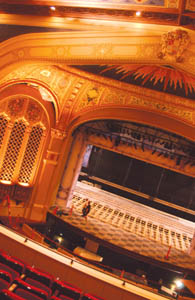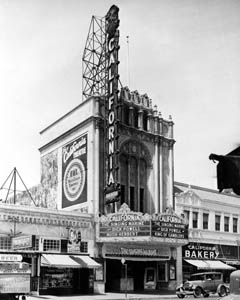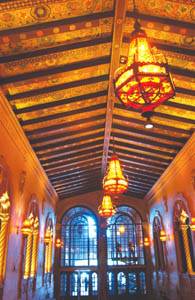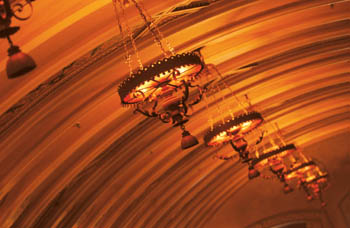![[Metroactive Movies]](http://metroactive.com/movies/gifs/movies468.gif)
[ Movies Index | Show Times | Silicon Valley | Metroactive Home | Archives ]
A Theater Is Born—Again
The heritage of a grand era in moviegoing lives again at the California Theatre in San Jose
By Richard von Busack
AFTER A QUARTER-CENTURY warm-up and five years of toil, cost and worry, San Jose just got itself one the most stunning opera houses on the West Coast, a symphony hall and a showcase for classic cinema, all in one building.
In general, the modern theater is a big box in a bold range of colors from brick to sand. Contrast these newer spaces with historic theaters, theaters that in so many cases have represented the hopes of revival of a downtown. More and more, we recognize that classic-era theaters are buildings of incalculable worth to the pride of a city. And now the California Theatre at 345 S. First St., San Jose, is finished.
Underneath the California Theatre's busy new electronic marquee on the Market Street Side was a lanky figure, carrying a very large camera. He wore a white hard hat with his name, "David W. Packard," printed on it. David Packard is the son of the Hewlett-Packard co-founder and the philanthropic head of the Packard Humanities Institute, which donated one-third of the cost of the renovation of the theater.
With Packard was James Goodman, a longtime architectural designer, who had worked on such projects as the restoration of San Francisco's Ferry Building and the flagship Williams-Sonoma store in Union Square.
Goodman is a taller version of Anthony Hopkins. He has the actor's air of pensive firmness. For the past three decades, Goodman has worked in the end of architectural design that involves color. After we took a tour of the theater, Goodman called recoloring the building, "The first fun I've had in years."
It may have been fun, but the less-fun part came first. At the end of this May, Packard broke the news to the city—as only a donor who came up with $25 million worth of a project can break bad news—that the painting job in the California Theater's auditorium was no good.
The trouble started this spring, with the sudden death of Tony Heinsbergen, son of the original artist who decorated the California Theatre; other frescoes by the elder artist are on the ceiling of the lounge at the Sainte Claire Hotel.
The painting continued under the younger Heinsbergen's designs, but when the scaffolding came down, the colors were not to Packard's taste. It was garish, he said. "A most screeching clash of colors, like a Vegas wedding chapel," added Goodman.
The scaffolding went back up in the auditorium. The New York-based restoration company Evergreen Studios went to work; the firm works on everything from old movie houses to state capitol buildings. Evergreen labored seven to 10 hours a week to make the deadline of the San José Opera's opening on Sept. 18.
"The city's been supportive, and they've never objected to anything I'd wanted to do," Packard said. Still, the philanthropist's decision to bring in a new colorist late in the game spurred some dismay in the Redevelopment Agency. This was particularly the case when the theater's lobby was repainted in the smoky-leather shades that were popular in the 1920s, but which aren't hues really found in the color boxes of today's designers. "You might as well paint it black." commented one frustrated city official, seeing the redo after the primer colors.
I called Sharon Jones, project director for the RDA, to ask what the city's response was to Packard's insistence to do the painting of the auditorium over. "Well," she said, followed by a quite long silence. "It took us a while to do the scheduling to see that his wishes were dealt with appropriately and to get the work done around it. It was very, very important for him. We needed to schedule the overtime, to make sure that when it was finished that it was closest to the original designs. In the end, it was the right thing to do to restore the theater."
"At the beginning," Packard said, "we'd budgeted $25 million for the project, and I set aside $5 million that I knew would be needed during the last eight or nine months. Sure enough, there was even a plan to do without the blade because of cost overruns"—the blade is the vertical part of the marquee bearing the theater's name in lights. "I told them it wasn't worth $75 million to make the theater look the way it looked. And I said, we have the money, and you don't have to pay for it."
After Packard broke the news that he wanted the theater's interior repainted, he found some Ektachrome slides of the California Theatre from Steve Levin, a Seattle-based theater historian and editor of the website historictheatres.org.
Levin said that in his opinion the auditorium "needed work" after the first round of painting was finished. Levin is the son and grandson of valley theater owners—his father ran the Strand Theater in Gilroy, among others. Levin had a habit of taking photos of theaters. His photos of the California Theatre "during its dying days" in the mid-1970s gave an idea of what the theater's walls and ceiling had looked like originally.
Fox Hunt
In 1973, the Fox California ended 46 years as the center of San Jose's nightlife. Changing times, the population's flight to the suburbs away from the crime-ridden downtown and a slump in ticket sales were the reasons for the theater's decline. This is a story that was repeated in inner cities all over the United States.
The California had been originally been built in 1927 for the West Coast chain, which was later purchased for Fox Theaters. The Fox California, as it was later known, was designed by architects Charles Peter Weeks and William Day. Considering how many exuberant buildings the pair constructed, the San Francisco firm of Weeks and Day is unsung.
The peak era of movie-palace creation in the 1920s was a time of unbound architectural exotica. Whatever was considered swank and sexy—King Tut, Rudolph Valentino, Don Juan and Carmen—ended up incorporated in the theater design. Movie palaces suggested castles in Spain and palazzos in Italy. Venice is remembered in hundreds of Lidos and Rialtos, Spain in scads of Alhambras and Granadas, and there are numberless Egyptians, Nile Theaters and Orientals.
The theaters of Weeks and Day were slightly different because they compressed Iberian and Italianate elements together. Weeks and Day's Mark Hopkins and St. Francis hotels in San Francisco still stand. The AMC Van Ness is a Weeks and Day-designed Cadillac dealership, with a facade of allegorical titans in masonry, shoulders to the wheel, holding up an automobile tire.
The ornate Copley Symphony Hall in downtown San Diego was originally the showpiece Weeks and Day-designed Fox Theater. Historian David Naylor has described the San Diego Fox as "a Gothic Revival church masquerading as a movie palace." This 1929 theater has an enormous English late-medieval chandelier from which decorative rafters radiate outward, like rays from the sun. The day the Fox San Diego opened, a week or so after the stock market crash, a vaudeville act performed, leaning out of the chandelier: six high-kicking chorus girls and an accordionist, performing in the middle of the air, 100 feet above the seats.
Few other examples of Weeks and Day theaters exist. Their Fox Burlingame was paved over in 1975, and their Fox Orpheum in downtown Oakland was demolished during BART construction.
Weeks and Day's Fox Oakland awaits possible restoration. The Babylonian tower on this vacant theater is probably a salute to D.W. Griffith's classic silent film Intolerance. Naylor calls the Mideastern theme of the Fox Oakland an unusual strategy by this "ordinarily conservative firm." Then again I doubt if Naylor saw the California Theatre, a place for which the words "ordinary" or "conservative" don't apply.
All of these phantasmagorical movie houses were built for the same reason kings built palaces: to establish a look of power and legitimacy for a new force in the world. Cinema comes in through the back door of history. It began as a dubious and probably dirty novelty, sold by foreigners with funny accents. The cinema palaces were built to demand respect from the passersby. "We sell tickets to theaters, not movies," theater impresario Marcus Loew once said.
The Bay Area is a national leader in preserving historical theaters. Both the mild climate and the sense of cinema as our state heritage have kept theaters alive, including the Castro, the Grand Lake, the Stanford, the Oakland Paramount, the Del Mar in Santa Cruz and even smaller theaters like the Jose. But considering the Goliath theater buildings that were common in even the smaller cities, the California Theatre is pretty much like nothing else on earth.
Jones gave me one tour, but I wanted to come back for seconds. The Redevelopment Agency calls the California Theatre "a mixture of Gothic, Moorish and Renaissance styles." They have to call it something. James Goodman referred to the theater's "tremendous whimsy woven by artistry."
"My personal theory," Goodman added, as we entered the theater, "is that different times and places meet here, that it's a miraculous fantasy world. It's a cultural crazy quilt."
In the main lobby is a kind of Venetian balcony, with mirrors behind it. On the right is a space for the lobby Wurlitzer, which wasn't reinstalled yet. The lobby organ was a feature in some of the poshest movie theaters of the 1920s, for crowds awaiting the next show.
The most surprising part of the main auditorium is a Florentine "false proscenium," a hollow, rounded space above the square arch where the curtain hangs. This false proscenium is painted with a stylized setting sun, with wavering pointed rays. Dark-blue and burnt-orange shades of night deepen around the edges and side panels. Perhaps this painting of sunset is an allegory, signifying the arrival of dreamtime on the stage and the screen below.
We sat up in the balcony, taking up three of the 1,119 red-velvet seats. On either side of the stage are Moorish/Islamic screens over the organ pipes. Above it all reigns a smiling dramatic mask, posed above twin cornucopias, spilling out tinted fruit. It could be that the mask represents Comus, the muse of comedy, son of Bacchus. Packard opined it was the goddess Demeter, because of the cornucopias. To Goodman, the mask is the theater's "house muse," which was nothing but scary until he repainted it. "It was a ghoulish greenish-gray, but I gave it a cast of warmth."
We climbed up past the projectors—70 mm film capacity, with safety equipment so that the potentially flammable nitrate prints can be screened. Between the ceiling and the roof are narrow catwalks, where electric winches lower the huge Spanish chandeliers so the light bulbs can be changed. The path to the rear exit wends down another ladder and past a wire-mesh net. You could walk a little ways on the net, over the sunburst on the false proscenium arch and look down into the auditorium.
The scenery for the upcoming premiere of Opera San José's production of The Marriage of Figaro hung at our level, in orderly flat rows. Shaking hands with my old pal vertigo, I got the full Phantom of the Opera view of the rows of seats seemingly half a mile below. "Great for throwing spitballs," Goodman commented.
The theater is decorated throughout with heraldic shields. They are ornamented with authentic Spanish arms, such as the castle of Castile, the rampant lion of Leon, as well as lone stars and fleurs-de-lis. The wavering stucco walls are Southwestern, mock adobe. Navajo-styled decorative panels are stenciled onto the ceiling. A wedding cakey "Swiss border" runs at the ceiling line—a row of cavorting cherubs. From the stage, one sees the balcony ornamented with Wedgwood medallions.
Newly expanded for opera, the orchestra pit is excavated in the Bayreuth style. It includes an elevator lift with what Packard called "room for three Mercedes" and more than enough power to raise the theater's main Wurlitzer organ for performances of silent films.
In the main lobby, the crowd will enter over adobe and blood-red hand-cast tiles. Above them are raised beams, covered with painted rosettes and dogwood flowers, interspaced with the theater's original floral frescoes, restored. Twisted Corinithian half-columns line the walls. This timbered lobby ceiling matches the raised beams in the auditorium, which are a new addition to the original design. The raised beams inside the auditorium conceal a necessary evil: the black metal "cans" of hanging spotlights are recessed into them.
Outside, the newly installed blade of the theater's marquee boasts twinkling clear light bulbs. The blade is crowned by a painting of California Arts and Crafts-style golden poppies.
A replica of the theater's original square-glass marquee replaces the more familiar plasticized one it had until recently. The plastic trapezoidal marquee of the 1950s was invented so that drivers in cars could read what was playing.
The design elements—pan-Spanish, movie-theater baroque, Mission and more—only start to get dizzying when you tally them up. While they never really collide visually, it's remarkable to see a theater that incorporates both Charles V and Junipero Serra.
When San Jose's Redevelopment Agency bought the out-of-business Fox California, nobody could agree on what was to be done with it. By the standards of the 1920s movie palace, the theater was about middle-size, small fry compared to mammoths like the long-gone Fox San Francisco, which seated 4,651 people.
San Jose's California Theatre was too big for the movies of the 1970s, but its stage was hardly large enough for any theatrical production bigger than a vaudeville act. And the acoustics of the auditorium were wrong for the San Jose Symphony. It showed foresight that after the RDA bought up the theater, "It was never on the chopping block," Jones says. But by the end of the 1990s, some thought was given to gutting the theater. "I thought that was a silly idea," Packard recalled, "and so I said let's take a month or so and do a study."
By the time the renovation by the construction management team of Rudolph and Sletten was through, the theater had been completely brought up to date. The city excavated a new service alley on First Street to take care of the Sainte Claire's garbage. This was to recompense the hotel for a few feet of land needed to expand the theater backstage on the Market Street side. A parking lot and a vacant lot were also used for extensions.
Now, the theater has a plaza on First Street for outdoor receptions, and elevator shafts for handicapped access. The building has been retrofitted with climate control and sprinkler systems. The builders rammed down pilings to brace the theater for seismic upgrading. The roof was doubled up to soundproof the theater from the planes. Not a hint of the constant aerial racket on First Street penetrates.
The back of the theater facing Market Street has had its old backstage area removed and rebuilt. Now it has a 103-foot stage tower and a newly widened stage. Underneath the stage lies a warren of dressing rooms. Nearby is a rehearsal room the exact size of the stage. This rehearsal space can also be rented, Sharon Jones noted, as a "black box" theater for small live one-act theater-style productions.
ELS Architects of Berkeley, which designed the new structures, created a suite of multiuse spaces. These offices are a part of the restoration that neither Packard or Goodman had anything to do with.
The best feature of the theater's second-story backrooms are large windows that open up right into the limbs of a sycamore. These multipurpose rooms with their separate entrance on Market Street could provide spillover units from McHenry Convention Center.
As architecture, the Market Street half of the theater is severely functional. At least it's a painstakingly accurate match of the parking garage across the street. If the auditorium of the California Theatre says, "By God, I'm a one-of-a-kind building in this brave, new state, gaze upon me!" the back part of the theater says, ringingly, "I'm a civic building, and the taxpayers didn't pay too much for me! The era of big government is over!" Civic architecture that's meant to impress can always backfire, as the blighted history of the scandal-plagued new San Jose City Hall cautions.
Packard, Goodman and I headed for Il Fornaio to finish up talking. Packard had known Goodman for about a decade, after Goodman had done work designing his house. "It was serendipity that he was available," Packard said.
Goodman came into the theater just after Memorial Day and started studying Levin's slides to make up a system of colors that would work. Part of the project included adding glazes to the walls to give them a warmer finish and redoing the lanterns in the mezzanine lobbies to recast their glow into a softer bronze. He also created an array of 80 or more colors as a file, so that future repainters will have references to work from.
Packard, an ex-professor of classics, has a number of philanthropic projects going at any time, but film preservation is his specialty. As a major funder of the UCLA Film Archive, Packard has helped finance the restoration of dozens of irreplaceable films. Almost 15 years ago, he restored the Stanford Theater, still one of the best places in the world to see Hollywood classic films.
He has a professor's expertise and sometimes a professor's impatience; his likes and dislikes are clear. Packard said that he leaned on the San José Opera to premiere with his favorite, Mozart's The Marriage of Figaro.
As we ate up Il Fornaio's bread and waited for lunch, Packard added that it was his strong recommendation that persuaded the Library of Congress to add 1939's The Shop Around the Corner to the national registry. The idea of a philanthropist putting his foot down shocked me a lot less than the idea that The Shop Around the Corner—Ernst Lubitsch's best film—hadn't made it to the registry until very late after the Library of Congress started the list.
Packard became a film fan late in life. In the middle of his career as an academic, he avoided the cinema. When he was teaching at the University of North Carolina, a colleague convinced him to have another look at The Wizard of Oz. When I'd interviewed Packard in 1986, I'd heard that part of the story and thought of the man as just one of the millions of fans captivated by that MGM fantasy. This afternoon, he mentioned that he'd gone on subsequent nights to see Meet Me in St. Louis and A Star Is Born.
What had really hooked him on movies, he said, was seeing Judy Garland in the course of three nights. She changed from the yearning child Dorothy Gale to the tender girl in Vincente Minnelli's often melancholy musical. Finally, she ended as the middle-aged Mrs. Norman Maine, at the end of her tether. Packard's voice got a little quieter as he described Garland in the three films. He said, it was like seeing a tree bloom and wither right before your eyes.
"I can impose my personality on the Stanford Theater, but the California Theatre will be different," Packard said. "Because the Stanford Theater's a nonprofit, we'd lose our property-tax exemption if we showed commercial films."
Since the city of San Jose owns the California Theatre, it will not only be the home for Opera San José and Symphony Silicon Valley but will also host film premieres and Cinequest events. The details are still being negotiated, but it is possible that one of the more anticipated computer-animated films of the fall is set for a charity premiere in October.
With the first night performance on Sept. 18, the newly reopened California Theatre will become a cultural centerpiece for San Jose's downtown. Restoring it was an unusually farsighted step in city planning. It seems certain this theater will be as much appreciated in future years, as we today can appreciate the grand thinking of those builders from nearly 80 years ago.
[ Silicon Valley | Metroactive Home | Archives ]
Copyright © Metro Publishing Inc. Metroactive is affiliated with the Boulevards Network.
For more information about the San Jose/Silicon Valley area, visit sanjose.com.
![]()
Fall 2004 Arts Guide:
[ Stage | Classical Music/College Series | Visual Arts | Pop Music | Movies | California Theatre ]

Color photographs by Dave Lepori

Marquee Names: The California in its movie heyday.

Fantasy World

Screen Gems

No schedule has been set for the films to be played at the California Theatre after the opera season is over, but it may be a different bill of fare than the Stanford. Packard's cutoff date of 1960 is something he breaks very rarely, mostly for complete retrospectives of Cary Grant or Billy Wilder. Occasionally, for retrospectives of favorite directors like Vincente Minnelli or Satyajit Ray, he will go later; Ray's 1990 picture The Stranger is the latest-date film shown at the Stanford Theater.
Send a letter to the editor about this story to letters@metronews.com.
From the September 8-14, 2004 issue of Metro, Silicon Valley's Weekly Newspaper.